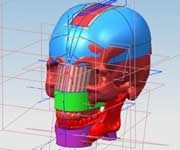Researchers at the University of Bristol’s Department of Mechanical Engineering in collaboration with the Department of Oral and Dental Science have developed the Chewing Robot to study dental wear formation on human teeth.
Dental elements, such as crowns and bridges, are made from well-known metals, polymers and ceramics but their dental wear properties are often poorly understood. Clinical trials examining the wear of human teeth are expensive and time-consuming. By the time a new material has been tested, it is often obsolete.
The movements and forces involved in natural chewing action have been replicated using the new chewing simulator – the Chewing Robot. The robot is based on a three-dimensional mechanism with six linear actuators that reproduce the motion and forces sustained by teeth within a human mouth.
A human jaw is a powerful and complex piece of natural machinery, allowing a person to chew in many different ways. The lower jaw and the teeth move with six degrees of freedom, translating and rotating along each of the Cartesian axes.
Dr Kazem Alemzadeh, Senior Lecturer in the Department of Mechanical Engineering recognised that the Stewart-Gough platforms have been used to provide and control the same six degrees of freedom in aircraft simulators, and so he proposed the Chewing Robot concept based on just such a platform. The design and development of the Chewing Robot was carried out by Daniel Raabe, a PhD student in the Department of Mechanical Engineering.
The robot has the potential to dramatically improve the process of developing and testing new dental materials.
Daniel Raabe said: “By reproducing natural bite forces and movements, the Chewing Robot can help improve and accelerate the process of developing new dental restorative materials that may someday be found in a person’s mouth.”
The Royal Society Summer Science Exhibition is the premier annual showcase for scientific excellence in the UK, and runs from Tuesday 30 June to Saturday 4 July at the Royal Society in London.
The exhibit, ‘The Chewing Robot: a new biologically-inspired way to test dental materials ’, sponsored by the Engineering and Physical Sciences Research Council (EPSRC), the Wellcome Trust, the Bristol Robotics Laboratory (BRL), Holford and Partners and the Department of Oral and Dental Science, is located in the City of London Room, ground floor.
Visitors to the stand will have the opportunity to find out more about biologically inspired design. Two interactive units will complement the Chewing Robot exhibit. The first being a teeth counting activity. The second interactive activity will enable people of all ages to make a mould of an upper or lower set of teeth using modelling Lab-Putty. The Chewing Robot replicates the human jaw, allowing it to generate wear formation on single dental elements.
The exhibit has been developed with the support of the University’s Centre for Public Engagement, which encourages academics to engage with the public.

